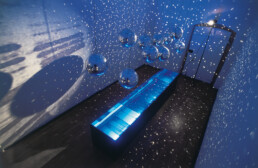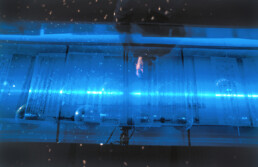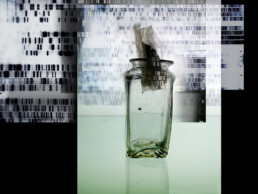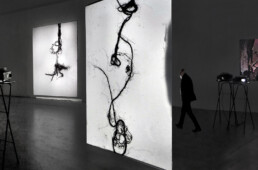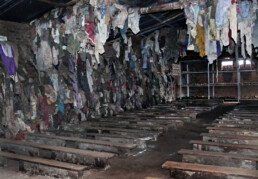Materials Reloaded
Relics – a genre of object that seems to have fallen completely out of time. They were originally objects that were in contact with saints or taken from their dead bodies. Since ancient times, the veneration of the saints was ignited by these remains. Accordingly, they were richly decorated and impressively staged.
Harald Fuchs, a renowned contemporary artist, takes a new approach to relics as traces of life, faith and memory. Fuchs is a media artist who works with light and videos, sounds and projections. In his artistic work, he builds a bridge between nature aesthetics and science aesthetics, old and new ideas of culture and nature. His works always play with associations and, precisely because of this, bring religious and scientific approaches to the world into conversation. Part of Harald Fuchs’ special way of working is to work on site, to collect and sense site-specific peculiarities, to stay for a long time, to take an almost ethnological, exploratory look at events and rituals. An art in which co-experience also gives rise to co-suffering.
In this double exhibition together with the Kulturverein Zehntscheuer e. V., the Cologne artist combines religious, aesthetic, scientific and political perspectives. He vividly illustrates that relics, as something material, open up paths into the immaterial and into memory – a power that was as effective then as it is today.
Reflections of the Holy
Installation in the Diocesan Museum
Taking the reliquaries in the Diocesan Museum as his point of departure, Fuchs shows that the containers still possess an aura of the sacred and the supernatural: a transcendent effect that the artist transfers into contemporary forms of expression. The fascinating thing about relics is their ambivalence: reliquaries veil and present in equal measure. Fuchs is inspired by the transparency, the atmospheric nature of the objects – and also by the remnants of perishable matter that some of them still harbour.
To accompany an installation of glass and light, Fuchs shows a video that takes up another area of traditional piety. A few years ago he was in Malaga and experienced the great procession that takes place there every year during Holy Week, Semana Santa. Under the monotonous sound of drums and brass music, a statue of the Madonna and Jesus are carried on many shoulders through the old town of Malaga. Fuchs has transformed the visual-auditory impressions of this religious practice into a sound installation.
444 frayed memories
Installation in the Zehntscheuer Cultural Centre
The expressiveness of traces of life is shown in a completely different, shocking and direct way in the exhibition area of the Kulturverein in the Zehntscheuer. The starting point for this is the clothing of 5,400 Tutsis who were beaten to death in a church during the civil war in Rwanda. Harald Fuchs was there, experienced this room, which has long since ceased to serve as a church, and collected some fibre remnants of the clothes still hanging there from the floor. Fuchs fixes these half-decayed original remains in slide frames and projects them onto large surfaces. The darkened room and the rhythmically changing large projections of the tiny fabric remnants create their own irritating atmosphere in the room. The sound of the clacking projectors almost seems like breathing in and out.
At the same time, the installation offers the viewer his or her own aesthetic world of experience. Without knowledge of the original site and its terrible history, the visitor is enveloped by a space and sound design with oversized graphic surfaces of its own beauty. But as in the case of the saints’ relics, the fibres bring the inconceivable and unspeakable to mind: they are dead matter and yet speaking testimonies of cruelly deceased people. They stand for death, for violence, for loss and pain, but also for hope and a powerful reminder.
Accompanying programme
Exhibition images
Harald Fuchs
Biographical
Harald Fuchs studied, among other things, free art (free graphics, photography) at the Academy of Fine Arts in Stuttgart with Prof. Rudolf Schoofs. His mentor was Dr. Manfred Schneckenburger, artistic director of “documenta 6” and “documenta 8”. Since 1995, Fuchs has taught as a professor of mixed media and artistic drawing at the Düsseldorf University of Applied Sciences. He lives and works in Cologne, Düsseldorf and Miasino (IT).
Artistic media
Installation, drawing, photography, light projection, video, sound, object
Awards (selection)
1990
Scholarship German Academy Villa Massimo Rome (to Casa Baldi/Olevano Romano)
1997
Hermann Claasen Prize for Photography and Media Art
2003
Culture Prize of the City of Rehau
2014
Joseph and Anna Fassbender Prize
Solo exhibitions and installations
(recent, selection)
2016
Bonn, LandesMuseum Bonn, “The Now Lasts 30 Milliseconds”
2016
Emsdetten, Galerie Münsterland e. V., “Living Materials-Rwanda”
2016
Berlin, Kunstverein Tiergarten, “The Part and Not the Whole”
2017
Bad Rothenfelde, Projection Biennale, “lichtsicht 6”
2018
Lesa, Museo Manzoniano, “I Promessi Sposi”
2019
Hamburg, Deichtorhallen, “1000 Realities”
2019/2020
Goch, Museum Goch, “Let’s Better Call It Indeterminacy”
